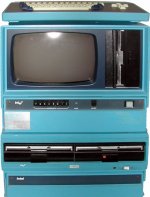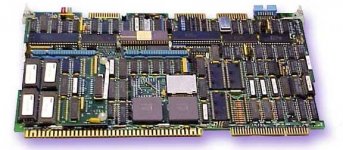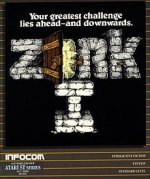Mine didn't have graphics ..lol.. first game was Colassal Caves Adventure. I had just started working at Intel in Jan of 1984. We developed the system below called a Series II/III. it ran an Intel OS call ISIS <-- go figure. The key game for it was Adventure.
My job was designing new CPU boards for it, is the picture of the board below was my first design. 80286 based single board computer. It allowed the series II to upgrade from an 8088 to a modern 286 cpu.. LOL. I designed a few more single board computers and in 1985 was a designer on one of the first 80386 IBM PC ATs. We had formed a skunk works team against , then CEO andy groves wishes. When Compaq/IBM and others caught wind of it - they came to benchmark it. both passed but we sold it into the OEM space and that started Intel's motherboard development team.
These SBC boards were used on the Shuttle launch pad. Several of them running a Real Time OS, Called RMX, would vote on launch criteria, failures etc.. The boards plug into a back plane, and you complete the Embedded system anyway you want by adding disk controllers, memory cards, comms etc..
*************************
YOU ARE STANDING AT THE END OF A ROAD BEFORE A SMALL BRICK BUILDING.
AROUND YOU IS A FOREST. A SMALL STREAM FLOWS OUT OF THE BUILDING AND
DOWN A GULLY.
go south
YOU ARE IN A VALLEY IN THE FOREST BESIDE A STREAM TUMBLING ALONG A
ROCKY BED.
**************************
View attachment 4182
View attachment 4183
Overview of Series II/III System
Mainframe Hardware
The Series III mainframe includes two host CPU's-an 8086 and an 8085A-to
provide enhanced performance and two native execution environments. Thus the Series
III is both an 8086-based development system and an 8085-based development system.
The system includes 224K bytes of iAPX 86,88 user memory, a 2000-character CRT,
detachable full ASCII keyboard with cursor controls and upper/lower-case capability, and a 250K-byte integral single-density floppy disk drive. Built-in interfaces are
provided for two serial I/O channels, a high-speed paper tape reader/punch, a line
printer or teletype, and the Intel Universal PROM Programmer. The Series III
operating system extends the user interface of previous Intellec development systems,
is software-compatible with them, and has a superset of their capabilities, thus
providing an easy upgrade path for users.
Figure 1-2 shows the Series III system as it appears when installed. Figure 1-3 shows
a system with an external dual-drive flexible disk subsystem; figure 1-4 shows a system
with a Winchester disk subsystem.
Supplied with the system is fundamental software including the Series III operating
system, 8086/87/88/186 Macro Assembler and other program development software,
plus a publications library containing all the technical manuals you need to use the
Series III hardware and fundamental software.


